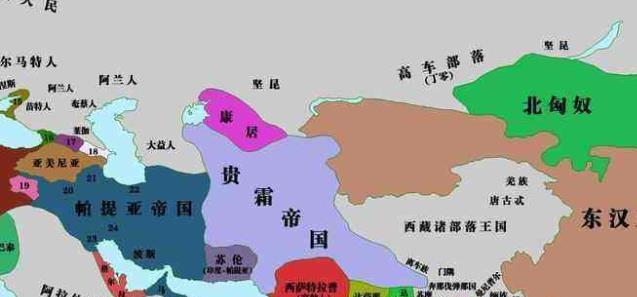The Sabbath Empire is not unfamiliar to us, after Zhang Qian went to the Western Regions, he continued to the west, and encountered the Sabbath Empire, which the Europeans called the Parthian Empire. This empire, which arose in 247 BC and ended in 224 AD, is very close to the existence of the Eastern and Western Han Dynasties, which is quite like a brotherly state.
Persia, before the rise of the Parthian Empire, was still under Greek rule. After alexander the great's death, his generals divided up the vast empire he had built, and it was Seleucus who occupied Persia.

The Parthians were an authentic ancient people of eastern Persia, and Arshak I drove out the Seleucid Empire during the rebellion of seleucid governors in the Parthian region. After years of war, around 168 BC, the whole Rest was unified.
When the Parthian Empire expanded to its maximum, it rivaled Cyrus II's ancient Persian Empire, controlling present-day Iran, Afghanistan, Pakistan, and northwestern India, becoming a powerful empire that dominated Central Asia. The Parthian army was probably the first ironclad cavalry, as well as the light cavalry, which was good at returning horses and arrows, and often wiped out the ancient Roman army.
Crassus, one of the first three giants of ancient Rome, the one who suppressed the Spartacus rebellion, originally wanted to find the Eastern peoples to brush the battle, but was defeated by the well-equipped Parthian army, and he himself was also poured into a stomach and died. It indirectly removed the obstacle to Caesar's rise to power.
In 121 BC, Zhang Qian visited the Parthian Emperor Mitridates II, and the Silk Road officially extended to Central Asia, leading to the ancient Roman Empire. Chinese silks, pearls, Spices and fruits from Central Asia, and high-end glassware from ancient Rome spread throughout Eurasia. The mighty lion was also given to the Han Dynasty by the Parthians, which opened Chinese's eyes.
The parthian empire was diverse in religion, mixing persian and Greek gods, and was not exclusive to other religions. It is possible that Buddhism was introduced to Parthia through the Kushan Empire and then to China. The Kushan Empire was founded by the Yueshi people that Zhang Qian was supposed to contact, in the area south of Afghanistan, between India and Parthia. It is also reasonable that Buddhism, which originated in India, spread along this route.
During the introduction of Buddhism to China, a prince of the Parthian Empire played a great role. He was the first person to transmit buddhist scriptures to China and can be said to be the founder of Chinese Theravada Buddhism. His name was Anschgaard.
Anshegao was the prince of the Parthian Empire, which had been established for hundreds of years, the ruling class was corrupt, and Anshegao believed in Buddhism at a young age, was poor and happy, and enjoyed a high reputation in the folk. When his father died, he should continue to the throne, but he ceded to his uncle, far from politics, left the motherland alone, became a monk, and traveled in all directions.
In the early years of the Han Huan Emperor, An Shigao came to China, and he named himself An Qing, the character Shigao. He found that Buddhism had spread to a certain extent in China, but it was still in a very primitive stage, there was not a single copy of Buddhism, and believers treated the Buddha, just like other gods, burning incense and prostrating their heads in the hope of eternal life. Therefore, Ansekor decided to translate the Buddhist scriptures into Chinese to promote the spread of Buddhism in China.
An Shigao learned Chinese as soon as he arrived in China, and he lived in Luoyang, translating a total of thirty-four and forty Buddhist scriptures, and now there are twenty-two and twenty-six volumes. These belong to Theravada Buddhism and were passed down in China until the Tang Dynasty. Master Xuanzang traveled west to India to seek sutras precisely because the Buddhas of the Tang Dynasty were no longer satisfied with the Hinayana sutras translated by An Shigao and wanted to find the Mahayana sutras native to India.
After ending his translation activities, Anschgaard traveled to various parts of the south. He is obviously proficient in some special techniques, and every time he goes to a place, he leaves a lot of magical stories. It is said that he was killed twice and resurrected, and it is not known whether it is related to his proficiency in medicine in the Kingdom of Rest.
Anseigao has been active in China for more than thirty years (and there is another theory that it is more than forty years), and the activities of translating the scriptures in Luoyang and traveling to the south (Jiangxi, Zhejiang, and other places) to perform miracles are obviously aimed at promoting Buddhism and accelerating the spread of Buddhism. He also recruited a wide range of disciples, and Yan Fotong, the only Han monk in the Han Dynasty, also learned from An Shigao.
With such a predecessor with the surname An, the Sabbath people who came to China regardEda High as their ancestor. They all changed their surname to An, settled in Gansu, and later slowly moved throughout China. Their appearance retains a certain characteristic of the Central Asian race, but it also gradually integrates into the Han chinese. Today, there are at least 1.7 million Chinese surnamed An, most of whom are descendants of the Sabbath Empire.